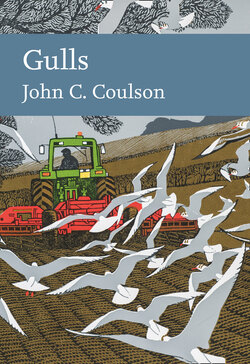Читать книгу Gulls - Professor John C. Coulson - Страница 6
Editors’ Preface
ОглавлениеGULLS ARE A FAMILY OF DISTINCTIVE and easily recognised birds that are familiar to us all, whether we live close to the sea or many miles inland, and whether we live in urban or rural surroundings. Long gone are the days when the sight of flocks of gulls overhead or in nearby fields was taken as a sure and ominous sign of storms at sea. For most of us today, birdwatchers or not, gulls are genuinely everyday birds, as common a sight as Woodpigeons (Columba palumbus) or the various members of the crow family. Other than in immature plumages (which may cause problems), the handful of commoner species are readily identifiable to those with any interest.
Seeking an expert author for a new book on gulls was a relatively easy task for the editors. Dr John Coulson was, until his retirement, Reader in Animal Ecology at the University of Durham, and has a lifetime’s experience of research into many aspects of gull (and other seabird) biology and ecology, with a particular focus on the Black-legged Kittiwake (Rissa tridactyla). He is an expert of world renown, and recipient in 1992 of the British Ornithologists’ Union’s highest accolade, the Godman-Salvin Medal, and in 1993 of the Waterbird Society’s Robert Cushman Murphy Prize.
A fulsome initial chapter introduces the gull family as a whole, including a succinct assessment of the rather complex current (worldwide) status of gull taxonomy. Things have changed dramatically since the eighteenth century, when Carl Linnaeus first established the single genus Larus, containing all the then known species! After this, the reader is treated to nine chapters – each in effect a treatise – on the regular British and Irish gulls, including the latest newcomer, the rapidly increasing and very elegant Mediterranean Gull (Ichthyaetus melanocephalus). These are followed by chapters on the rarer species; methods used in studying gulls; urban problems; and conservation, management and exploitation.
In common with many components of our fauna and flora, times have changed for gulls, and not always for the better – as the author describes. They may not universally be seen as slender-winged, elegant seabirds, and to some – especially those living in or visiting towns or cities with rooftop gull colonies – they are raucously noisy neighbours. Similarly, many seaside promenades are blighted by the menacing presence of gulls with unblinking eyes seeking scraps, often boldly. Since the late twentieth century, even conservation bodies seeking to encourage nesting terns or other seabirds have resorted to culling in an attempt to limit predatory gull activity. In the last few decades, however, Herring Gull numbers, boosted in the second half of the twentieth century by the ready feeding opportunities offered by poorly covered landfill sites, have fallen to the extent that they themselves have become of conservation concern.
Such problems, as well as the many fascinating but less nefarious aspects of our British and Irish gull populations, are dealt with in substantial detail in John Coulson’s admirably comprehensive text. This is a most noteworthy addition to the New Naturalist Library.
